
| Version | Summary | Created by | Modification | Content Size | Created at | Operation |
|---|---|---|---|---|---|---|
| 1 | Beatrix Zheng | -- | 2108 | 2022-11-23 01:32:47 | | | |
| 2 | Beatrix Zheng | Meta information modification | 2108 | 2022-11-23 11:04:44 | | |
Video Upload Options
Crash boats, at the time known as "aircraft rescue boat" or "air-sea rescue boat" were wooden speedboats built to rescue the crew of downed United States and other Allies aircraft during World War II. US boats came from observation of British experience with High-speed launches during the Battle of Britain. By the end of World War II America had produced 300,000 planes, creating a need to have crash rescue boats stationed around the globe. These boats were fast boats used to rescue pilots, crew and passengers from downed aircraft in search and rescue, air-sea rescue missions. The boats would race out to a crash site and rescue wounded aircrew. Some speed boats built before the war were acquired and converted to be crash boats and many new boats were built. Standard crash boats were built in four lengths for World War II. The smallest standard size boat was 42 feet long. The larger boats were 63 or 85 or 104 feet long. They were built for the Army Air Forces, US Navy and some were transferred to Allies. The design was similar to patrol boats built for the war, but with less or no armament and first aid equipped. The boats were designed to be light and fast to be able to get to the downed aircrew as fast as possible. Most were used in the Pacific war across the vast South Pacific, in the Island hopping campaign. Some were station on the West Coast of the United States to support the vast training centers. Many were designated Air Rescue Boats or ARB or AVR or P or C or R Hull classification symbol. After the war most were abandoned or destroyed, a few served in the Korean war (with United States Air Force ), some sold to private and some donated to Sea Scouts.
1. 42-Foot
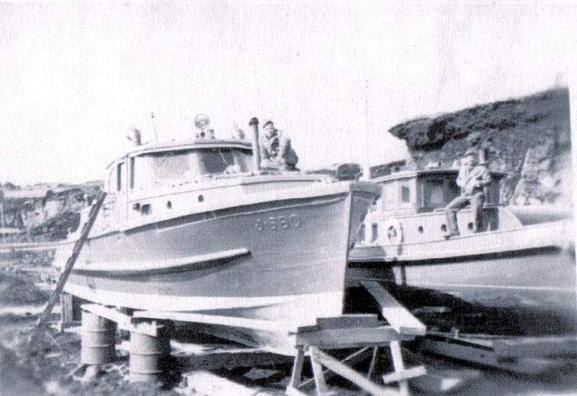
The 42 foot crash rescue boat were built for Army Air Forces Air-Sea-Rescue. The 42-foot (13 m) boat used design 221, with twin gasoline-powered engines, with two screws. These used two Hall-Scott/Hudson Invader Marine Engine or a Kermath Sea Ranger 6 Marine engine. Due to the small size, these were used in close-to-shore rescue. The boat had no armament. The 42-foot boats were built by Hunt Boat Company, in Richmond, California, Palmer Scott & Company in New Bedford, Massachusetts and Palmer Johnson Yachts in Sturgeon Bay, Wisconsin.[1]
-

42 foot boats built for US Army, cutaway. https://handwiki.org/wiki/index.php?curid=1239598
-

42 foot boats built for US Army. https://handwiki.org/wiki/index.php?curid=1883020
2. 63-Foot
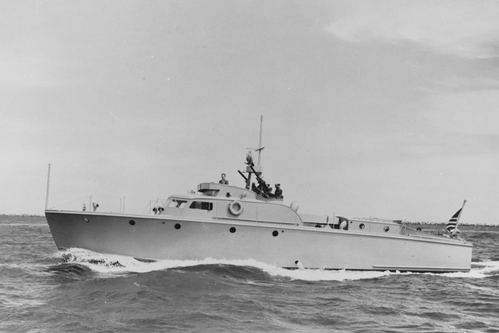
The 63-foot crash boats are known as AVR-63 or Class III boats. AVR class for Auxiliary Vessel, Rescue. The 63-foot (19 m) crash boat had two main Models the 314 design and the 168 design. They are 23 long tons (23 t), length of 63 ft (19 m), beam of 15 ft 4 in (4.67 m), draft of 4 ft (1.2 m), a lite 37,000 lbs and full up to 50,500 lbs. Design 314 was powered by two 630-horsepower (470 kW) Hall-Scott Defender V12 petrol engines with a top speed of 31.5 knots (58.3 km/h; 36.2 mph). The 168 design was powered by two Packard 4M-2500 with 1,250-horsepower (932 kW). They had a crew of 7 or 8 and were armed with two .50 calibre M2 Browning machine guns. The Model 314 boat has two rigid 795-US-gallon (3,010 l; 662 imp gal) United States Rubber Company bullet sealing fuel tanks, the 168 design had three tanks. In addition to the main two designs: 314 and 168, there were sub design models: 127, 152, 252, 293, 416, 440, Mark 2, Mark 3, Mark 4. By the end of the war 740 of the 63-foot boats were built by 15 shipyards. The first 63 foot, model 127, built by Miami Shipbuilding Corporation and used four Kermath 500 hp Sea Raider engines, as the Packard and the Hall-Scott engines were available. The eight model 127 went to South Africa then later model 252 also the them.[2][3] A few 63-foot boats were built post World War 2, noted as Mark 2, 3, and 3 models.[4][5] Model 152 were sent to Great Britain, these has a Watson-Flagg VeeDrive Gearbox added to them.[6] Model 168 built for US Navy with two 1250 hp Packard 4M-2500 marine engines for top speed if 48 knots (55 mph). Model 440 were "Q" boat for six US Army command boats. Model 416 was the same as the standard 314, but with firefighting system added, two water nozzles were added to the fore deck. Not all 63-foot boats were used for Crash boats, Model 293 was designed to be an offensive. The Model 293 were PTC or SC for Small Sub Chaser. Some Model 293 were transferred under Lend-Lease to Russia and classified RPC for Russian Patrol Craft. Model 293 was armed with Oerlikon 20mm cannon, depth charges and an extra fuel tank.
The 63-foot boats were built by Harbor Boat Building Company on Terminal Island in San Pedro, California , Fellows & Stewart in San Pedro, California, Stephens Bros. Boat Builders in Stockton, California, South Coast Shipyard in Newport, California, and Miami Shipbuilding Corporation, Miami, Florida.[1][7][8][9][10][11][12][13]
The British Power Boat Company built the Type Two 63 ft HSL 63-foot crash boat for the UK from 1937.
-
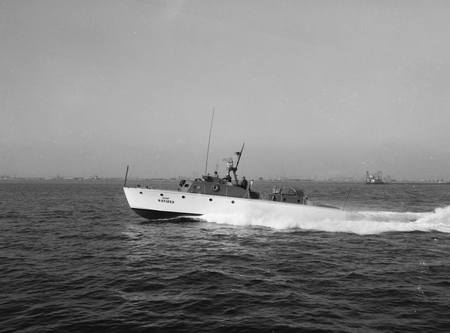
63 ft (19 m) air-sea rescue boat. https://handwiki.org/wiki/index.php?curid=1895144
-
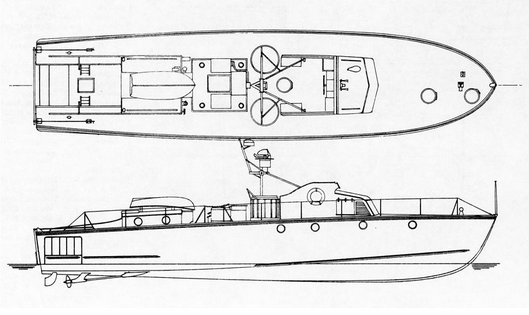
63 ft (19 m) air-sea rescue boat. https://handwiki.org/wiki/index.php?curid=1333629
-

63-foot ASR 313 built in 1943 with Reserve Officers' Training Corps in 1984. https://handwiki.org/wiki/index.php?curid=1594934
-

Stephens Bros. Boat Builders in Stockton, California, with 63-foot in 1944. https://handwiki.org/wiki/index.php?curid=1940926
-
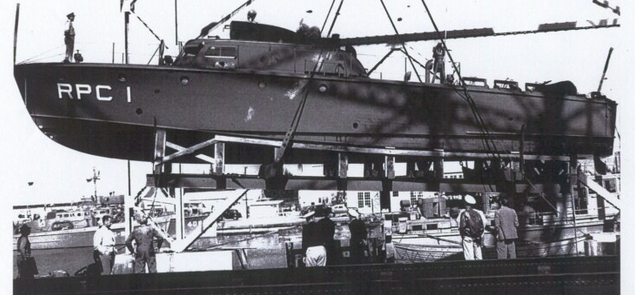
Model 293 transferring to the USSR as a patrol vessel in 1942. https://handwiki.org/wiki/index.php?curid=1945462
-

63-Foot Crash boat AVR at sea 1945. https://handwiki.org/wiki/index.php?curid=1534322
3. 85 Foot

The 85-foot crash boats are known as the ASR-85s or Class II boats. ASR-85s are known for having both speed and range, able to recover downed crews several hundred miles offshore. The 140 built 85-foot (26 m) crash boats are powered with two 1,500 hp (1,100 kW) Packard Marine 4M-2500 engines, with a top speed of 40 knots (74 km/h; 46 mph), a range of 2,500 miles. ASR 85 boats used 140 gallons per hour of 87-91 octane gasoline, tender ships would refuel and restock boats not stationed at harbors. Boats had no armament or were armed with twin 50 caliber machine guns and a 20 mm Oerlikon anti-aircraft gun. The ASR-85s had a crew of 12 men: one master, two engineers, one first mate, one navigator, one radio operator. three Able seaman, one oiler; one Emergency medical technician; and one cook, but cross training on these small boats was mandatory. ASR-85s were built by 14 shipyards: Wilmington Boat Works in Wilmington, California, Peterson Builders and Simms Bros. in Dorchester, Boston, Herreshoff Manufacturing in Bristol, Rhode Island, Burger Boat in Manitowoc, Wisconsin, Dooley's Basin & Dry Dock in Fort Lauderdale, Florida, Cambridge Shipbuilding in Cambridge, Maryland; Daytona Beach Boat Works in Daytona Beach, Florida; Eddy Shipbuilding in Bay City, Michigan; Henry B. Nevins, Incorporated in City Island, Bronx; Peterson, Julius in Nyack, New York; Robinson Marine in Benton Harbor, Michigan; Truscott Boat & Dock Co. in St. Joseph, Michigan and Fellows & Stewart in San Pedro, California. Example: AVR 661 placed on the U.S. National Register of Historic Places as#80001342 in 1980.[14][15] [16][17][18] P-550 is the only restored to original 104s crash boat. P-250 was stationed at Avila Beach, California for World war 2, supporting training at Amphibious Training Base Morro Bay and other training camps and airfields near San Luis Obispo like Camp San Luis Obispo. P-520 then served in the Korean War from 1950 to 1952. P-250 was built by Casey Boat Builders in 1943.[19][20] [21][22] [23][24][25]
-
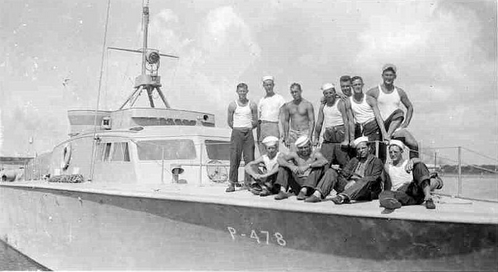
Crash boat Type ASR85, P-478 in 1943. https://handwiki.org/wiki/index.php?curid=1893280
-
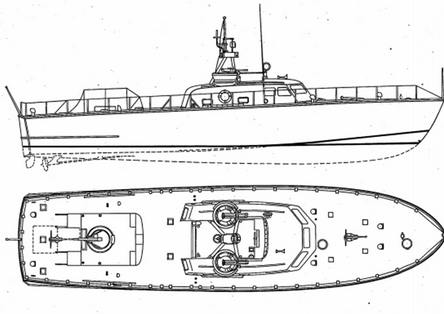
85-foot crash boat. https://handwiki.org/wiki/index.php?curid=1662087
-
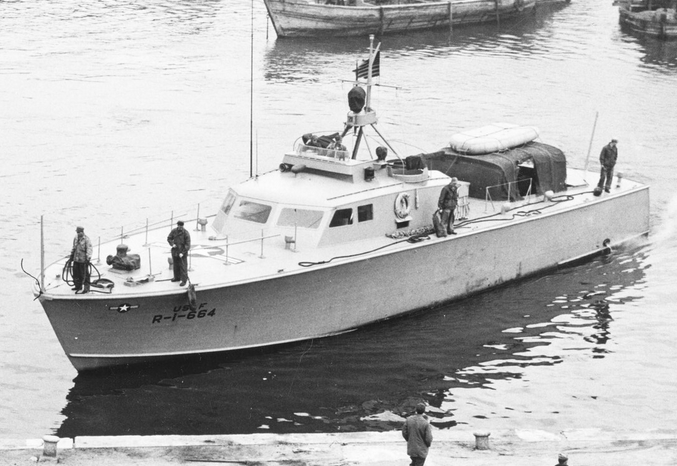
US Air Force 85-foot crash rescue boat in Korea. https://handwiki.org/wiki/index.php?curid=1651683
-
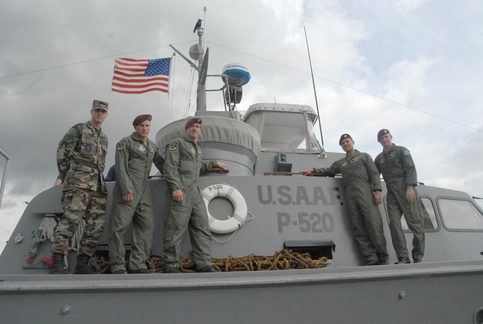
Air Force Reserve Airmen from the 304th Rescue Squadron, on P-520 a Crash Boat on the Willamette River in Portland, Ore. https://handwiki.org/wiki/index.php?curid=1930192
4. 104 Foot
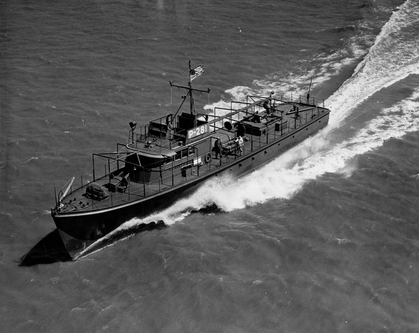
The largest of the crash boats, the 104-foot crash boats are also called "Class I" boats or 104s. The 104-foot (32 m) used Design 235, were built with emergency medical facilities which could accommodate up to 23 people. The crew of 12 were all cross-trained to operate any part of the boat. The boats have a length of 104 ft (32 m), powered by three 625 hp (466 kW) Kermath V12 engines, 3 screws. The boat had a top speed of 18 knots (33 km/h; 21 mph). The 104-foot was large enough to operate in the open ocean easily. Some 104-foot worked in the Gulf of Alaska and Aleutian Islands, these had cold weather options installed. The cold weather options had a heating system, ice protection on the hull, insulation. Many of the 104-foot boats served in the South Pacific and the Caribbean. The 104-foot boats were built by Dooley's Basin & Dry Dock; Casey Boat Builders in Fairhaven, MA; Ventnor Boat Works of Atlantic City, NJ; Dachel-Carter Shipbuilding, Benton Harbor, MI; Brownsville Boat of Brownsville, TX; Sagstad Shipyard, Seattle, WA.; Stephens Brothers of Stockton, CA. Example MV Christmas Seal.[26][27][28][29][30]
5. United States Coast Guard
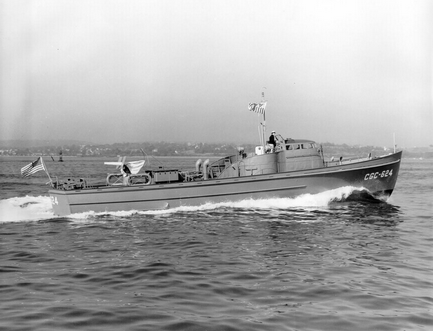
The United States Coast Guard operated 83-foot patrol boats, also used in rescue work.[31]
6. Other Crash Boats
- Some stock recreational speed boats were purchased for near-shore crash boats for the Army and Navy, these were 22 to 42-foot boats.
- Chris-Craft built 31 22-foot boats in 1943, J 631-661, for the US Army[32]
- USS Shadow III (SP-102) built in 1919
- Some 80-foot PT boats, with three engines and four 21" torpedoes, were put into service as crash boats.
- RCAF Nictak (M 447) a Motor Torpedo Boat built in 1941 was later used as a high speed Rescue launch for rescue work [33]
- USS Secret (SP-1063) built in 1917
- 40-foot US Navy rescue boats (1951).[34][35]
- 45-foot US Navy rescue boats.[36]
- 65-foot US Navy rescue boats.[37]
- 19 foot airboat US Navy rescue boats, 1966.[38]
7. Motors
7.1. Hall Scott Defender
Hall Scott Defender powered most 63-foot Rescue Boats. The Hall Scott Defender is a straight-six engine with overhead valves and two spark plugs per cylinder. The engine uses two updraft carburetors. The first run of 1996 CID had 575 hp, the next run was supercharged and bored and had 700 hp.[39][40]
| 63 ft. Rescue Boat model # | Number built | Number of Engines | Total Engines | Notes |
| 152 | 8 | 2 | 16 | For Britain boats. |
| 293 | 76 | 2 | 152 | Used in subchaser version of the boat. Some sent to Russia. |
| 314 | 352 | 2 | 704 | Used in 240 US Navy 240 boats. Some boats sent to the Netherlands and the U.K. The U.S.C.G. received 29 and U.S. Army Air Force received 54. Australia was sent 20. The ones that went to the Coast Guard became its standard 63-foot rescue boat for World War Two and into the 1950s. |
| 416 or Type 3 | 79 | 2 | 158 | Used in 416 US Army specifications boats. |
| Mark 2 | 16 | 2 | 32 | |
| Mark 3 | 69 | 2 | 138 | |
| Mark 4 | 9 | 2 | 18 | |
| Total | 609 | 1,218 |
- Hall-Scott produced Invader engines built in 1942:.
| Type | Number built with Invaders | Engines per boat | Total Engines | Notes |
|---|---|---|---|---|
| U.S. Navy-Army 63-Foot Rescue Boat | 20 | 2 | 40 | US Army received 6 of the V-12 Defender engine. |
| U.S. Army 42-Foot Rescue Boat | 2 | The 42-foot rescue boats were built with either Kermath Sea Raider or Hall-Scott Invader engines. |
- Engines for US Army Aircraft Rescue Boat 104 foot (P110-115 141-145)
| Type | Number built | Engines per boat | Total engines | Notes |
|---|---|---|---|---|
| 104 foot ARB | 11 | 3 | 33 | There were 93 104-foot rescue boats built. The original series had Kermath Sea Raider engines. The next series, known as the 200 series, was powered by the Hall-Scott Defender. |
7.2. Packard V12
The 85-foot crash boat used two Packard V12 Marine Engine engines, Packard V12 4M-2500. This was the same engine in the PT-boats, but PT boats had three engines. The 1,200 hp to 1,500 hp used 91 to 100 octane gas. The engine used a supercharger. The engine had a four-stroke, 60-degree V-12 with a 6.40-inch bore and a 6.50-inch stroke. The engine had 2,490 cubic inches and four valves per cylinder. To keep weight down this was an aluminum block with steel cylinder sleeves, each weighing 2,900 pounds. The engine had a 6.4:1 compression ratio.[41][42][43][44]
7.3. Kermath
Kermath Engines built two engines the Sea Raider Special that is a V12 engine the original one used in 104-Foot boats, Sea Raider Special have four overhead valves per cylinder, overhead cams and two spark plugs per cylinder. Outputting 450 to 550 hp each. The 104-Foot boats used. The Sea Raider Six engine was used in 42-foot boats, this is straight six with four overhead valves per cylinder and overhead cam. Two spark plugs per cylinder, with 260 hp. The Sea Raider Six had a 4.9 to 1 compression ratio and used 72 octane gasoline.[45][46]
8. Place Names
Crashboat channel in Hawaii (21°27′09″N 157°47′01″W / 21.4525°N 157.78361°W / 21.4525; -157.78361 (Crashboat channel)[47]) is named for the crash boats of World War 2 that rescued pilots who met misadventure in the vicinity of Kaneohe Bay, Oahu.[48]
References
- "Design & Construction of Boats". https://uscrashboats.org/cpage.php?pt=4.
- "Miami Shipbuilding". Shipbuildinghistory.com. 2016-11-23. http://shipbuildinghistory.com/shipyards/emergencysmall/miami.htm. Retrieved 2021-02-23.
- "Hall-Scott Motor Car Company in World War Two". Usautoindustryworldwartwo.com. https://usautoindustryworldwartwo.com/hall-scott.htm. Retrieved 2021-02-23.
- "USAF Mark Series Crash Boats". https://uscrashboats.org/cpage.php?pt=16.
- "Operator's Manuals - Downloadable". https://uscrashboats.org/fileDownload.php?cid=7&sid=1.
- "Vee Drive Gearbox". https://www.pt-boat.com/veedrive/veedrive.html.
- Dunn, Peter (2008). "Air-Sea Rescue Boats, RAN, during WW2". Australia at War. http://www.ozatwar.com/ran/asrboats.htm. Retrieved 14 February 2013.
- Thompson, R.H.J. (November 2011). "Fairmile class patrol boats and kin ships: a brief history". The Fairmile Association. Archived from the original on 11 April 2013. https://web.archive.org/web/20130411060411/http://ranveteranswelfare.asn.au/news/12%20News/FA%20Misc.%20Brief%20History.pdf. Retrieved 14 February 2013.
- Navy, corporateName=Royal Australian. "HMAS Air View". https://www.navy.gov.au/hmas-air-view.
- "Development of the Miami 63-foot Aircraft Rescue Boat by Jean E. Buhler". https://www.cnrs-scrn.org/northern_mariner/vol18/tnm_18_3-4_173-184.pdf.
- SS Tiger Shark http://www.scottdavis61.com/avr.html
- "ARB, SS Tiger Shark, Deck blueprint top view". http://www.scottdavis61.com/avrbp1.jpg.
- "SS Tiger Shark, Deck blueprint side view". http://www.scottdavis61.com/avrbp2.jpg.
- "Burger & Burger". Shipbuildinghistory.com. 2020-09-12. http://shipbuildinghistory.com/shipyards/yachtlarge/burger.htm. Retrieved 2021-02-23.
- "Broward Marine, Broward Shipyard". Shipbuildinghistory.com. 2020-09-05. http://shipbuildinghistory.com/shipyards/yachtlarge/broward.htm. Retrieved 2021-02-23.
- Grant, Monica (2020-08-24). "Crashboat 'Intrepid' Comes Home to San Francisco Bay Area". Latitude38.com. https://www.latitude38.com/lectronic/return-of-the-intrepid/. Retrieved 2021-02-23.
- "AVR website". Avrsociety.homestead.com. http://avrsociety.homestead.com/Links.html. Retrieved 2021-02-23.
- "85 ft. Army Air Force Rescue Boat". https://uscrashboats.org/cpage.php?pt=11.
- "Welcome To My Website". http://www.p-520crashboat.com/.
- "Operator's Manuals - Downloadable". https://uscrashboats.org/fileDownload.php?cid=8&sid=1.
- Giovan, Constantine N. (1980). "AVR 661 (Crash boat)". National Register of Historic Places Inventory-Nomination Form (National Park Service).
- "Dictionary of American Naval Fighting Ships". Department of the Navy, Naval Historical Center. Archived from the original on 2007-08-24. https://web.archive.org/web/20070824020721/http://www.history.navy.mil/danfs/abbreviations.htm.
- Photo of a 63 ft (19 m) AVR. http://www.ctie.monash.edu.au/hargrave/radioplane_navy.html
- Home of AVR's http://scottdavis61.goodluckwith.us/avr.html/
- "1/72 PT Boat Engines - Carrierbuilders community". July 23, 2011. https://web.archive.org/web/20110723035459/http://www.carrierbuilders.net/forum/index.php?s=71036e13cf43bdb17b3deb90cc2186d1&showtopic=415.
- Fowler, Chuck (2009). "Bill Somers' Military Service, The World War II Crash Rescue Boat Years". Puget Sound Maritime Historical Society. http://www.warboats.org/psmhf.htm. Retrieved 21 September 2012.
- "M.V. "Christmas Seal" entering Twillingate Harbour". https://www.mun.ca/mha/pviewphoto.php?Record_ID=3061&pagev=1.
- Fighting Tuberculosis in Newfoundland and Labrador http://www.heritage.nf.ca/society/fighting_tb.html#seal
- "104 ft. Army Air Force Rescue Boat". https://uscrashboats.org/cpage.php?pt=12.
- "History of the WWII AAF Crashboat". http://www.warboats.org/crashboat.htm.
- "Matchbox 60 vital to success of Operation Neptune". Bright Mountain Media, Inc.. June 6, 2015. https://coastguardnews.com/matchbox-60-vital-to-success-of-operation-neptune/2015/06/06/.
- Chris-Craft WW2 http://usautoindustryworldwartwo.com/chris-craft.htm
- "PT-6 (2)". Navsource.org. http://www.navsource.org/archives/12/05006b.htm. Retrieved 2021-02-23.
- "40' Boats of the United States Navy". Maritime.org. https://maritime.org/doc/boatcat/cat-0075.htm. Retrieved 2021-02-23.
- "Boat, 40". https://www.history.uscg.mil/Browse-by-Topic/Assets/Article/2026708/boat-40-utility-boat-utb/.
- "45' Boats of the United States Navy". Maritime.org. https://maritime.org/doc/boatcat/cat-0081.htm. Retrieved 2021-02-23.
- "65' Boats of the United States Navy". Maritime.org. https://maritime.org/doc/boatcat/cat-0128.htm. Retrieved 2021-02-23.
- "19' Boats of the United States Navy". Maritime.org. https://maritime.org/doc/boatcat/cat-0014.htm. Retrieved 2021-02-23.
- "Hall-Scott Defender Engines". https://uscrashboats.org/cpage.php?pt=14.
- "Operator's Manuals - Downloadable". https://uscrashboats.org/fileDownload.php?cid=15&sid=1.
- "Packard V12 Marine Engine". https://uscrashboats.org/cpage.php?pt=15.
- "Packard". http://usautoindustryworldwartwo.com/packard.htm.
- "Operator's Manuals - Downloadable". https://uscrashboats.org/fileDownload.php?cid=12&sid=1.
- "Operator's Manuals - Downloadable". https://uscrashboats.org/fileDownload.php?cid=11&sid=1.
- "Kermath Engines". https://uscrashboats.org/cpage.php?pt=30.
- "Operator's Manuals - Downloadable". https://uscrashboats.org/fileDownload.php?cid=25&sid=1.
- U.S. Geological Survey Geographic Names Information System: Crashboat channel, Honolulu County, Hawaii https://geonames.usgs.gov/apex/f?p=gnispq:3:::NO::P3_FID:365060
- Clark, John R. K. (2002). Hawaii Place Names: Shores, Beaches, and Surf Sites. University of Hawaii Press. ISBN 0824824512. OCLC 611657080. https://books.google.com/books?id=GRVjWztw5GcC&pg=PA54.




